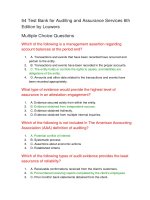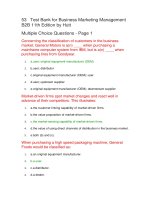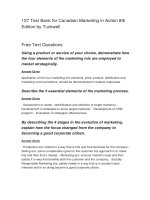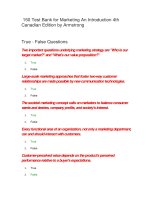Test bank for abnormal or exceptional mental health literacy for child and youth care 1st edition by gural
Bạn đang xem bản rút gọn của tài liệu. Xem và tải ngay bản đầy đủ của tài liệu tại đây (249.26 KB, 11 trang )
Test Bank for Abnormal or Exceptional: Mental Health Literacy for Child and Youth Care 1st
edition by Deborah M. Gural, Dawne Mackay-Chiddenton
Link full download test bank: />Link full download solutions manual: />
Chapter 2: Trauma- and Stressor-Related Disorders
Multiple Choice Questions
Learning Objective 2.1 – Distinguish between stress and trauma.
1. Shannon is concerned about her upcoming presentation in economics class. Her emotional,
cognitive, and physical responses to this event are referred to as
a) stressors
b) trauma
c) stress
d) neglect
Answer: C
Page Reference: 66
Skill: applied; Difficulty: easy
2. The major difference between a stressor and a traumatic event is that a stressor
a) is associated with physical symptoms
b) is more likely to result in mental disorder
c) is a part of daily life
d) is outside of everyday experiences
Answer: C
Page Reference: 66
Skill: conceptual; Difficulty: easy
Learning Objective 2.2 – Distinguish between the three trauma- and stressor-related disorders and the
three dissociative disorders summarized in the text, and describe their symptoms.
3. Disorders in which there is a disruption of normally integrated functions (perception, consciousness,
memory, identity) are referred to as
a) Stressor-related disorders
b) Dissociative disorders
c) Trauma-related disorders
d) Attachment disorders
Answer: B
Page Reference: 68
Skill: conceptual; Difficulty: easy
4. Bea feels removed from her feelings and environment and has moments where she feels she is
seeing herself from across the room. This best illustrates
a) derealization
b) delayed expression
c) depersonalization
d) amnesia
Answer: C
Page Reference: 68
Skill: applied; Difficulty: moderate
© Copyright 2016 Pearson Education, Inc.
17
5. Sally has been diagnosed with PTSD. She continues to experience distressing memories that just pop
into her mind and in her dreams no matter how much she doesn’t want to experience these. These
experiences BEST illustrate which of the four major areas of symptoms for PTSD?
a) intrusion symptoms
b) amnesia
c) arousal and reactivity
d) avoidance
Answer: A
Page Reference: 69
Skill: applied; Difficulty: moderate
6. Phil was in a serious car accident and has suffered with nightmares and avoidance of cars for two
weeks. He would BEST be diagnosed with
a) Adjustment disorder
b) Dissociative amnesia
c) PTSD
d) Acute stress disorder
Answer: D
Page Reference: 70
Skill: applied; Difficulty: challenging
7. Larry has been writing exams and is experiencing extreme distress, inability to experience positive
emotions, and difficulties concentrating and sleeping. These symptoms are now interfering with his
performance and relationships. Although his friends are managing exams well, he is having
significant difficulty coping with them. Larry would most likely be diagnosed with
a) Adjustment disorder
b) Dissociative amnesia
c) PTSD
d) Acute stress disorder
Answer: A
Page Reference: 70
Skill: applied; Difficulty: challenging
8. Fredrica has memory loss for several hours of every day. At times, she talks in a high-pitched child’s
voice and is passive and quiet while at other times, she is aggressive, hostile, and claims she is a 40year-old man. Which diagnosis would be most appropriate for Fredrica?
a) Depersonalization disorder
b) Dissociative amnesia
c) Dissociative identity disorder
d) Dissociative fugue
Answer: C
Page Reference: 71
Skill: applied; Difficulty: easy
© Copyright 2016 Pearson Education, Inc.
18
9. After witnessing her brother get shot in a bank robbery, Philomena cannot recall any details of that
day. This best illustrates
a) Depersonalization disorder
b) Dissociative amnesia
c) Dissociative identity disorder
d) Dissociative fugue
Answer: B
Page Reference: 71
Skill: applied; Difficulty: easy
Learning Objective 2.3 – Summarize the concepts of complex trauma, developmental trauma, and
relational trauma.
10. Jen has experienced various forms of maltreatment throughout childhood including sexual and
physical abuse and exposure to family violence. She now exhibits self-concept challenges, anxiety,
and attachment difficulties as a result. From a CYC perspective, this would best be described as
a) parental detachment
b) stress
c) complex trauma
d) social neglect
Answer: C
Page Reference: 73
Skill: applied; Difficulty: easy
11. All of the following are true according to a CYC approach to trauma EXCEPT
a) after exposure to a traumatic event, a pattern of over-arousal is always observed
b) youth in the justice and child welfare systems have usually experienced maltreatment
c) in understanding youth responses to trauma, both risk and resiliency factors must be examined
d) older youth are likely to self-medicate with various substances to manage symptoms of trauma
Answer: A
Page Reference: 72-77
Skill: factual; Difficulty: challenging
12. What can we conclude regarding the role of age and developmental stage in trauma?
a) symptoms of trauma are entirely different from one person to the next
b) symptoms of trauma can vary significantly across different age groups
c) developmental stage has little to do with the type of trauma symptoms observed
d) early trauma-related disturbances are always temporary due to child resilience
Answer: B
Page Reference: 78-79
Skill: conceptual; Difficulty: easy
© Copyright 2016 Pearson Education, Inc.
19
13. When she was 3-years-old, Amanda was removed from her home because of inadequate care by her
biological parents. She was placed in multiple foster homes over the course of her childhood and
didn’t always receive the care and nurturance she needed. Amanda’s experience BEST illustrates the
concept of
a) parental detachment
b) stress
c) multifinality
d) social neglect
Answer: D
Page Reference: 79
Skill: applied; Difficulty: moderate
14. Which of the following diagnostic categories applies primarily to children?
a) Disinhibited Social Engagement Disorder
b) Acute stress disorder
c) PTSD
d) Adjustment disorder
Answer: A
Page Reference: 79-80
Skill: factual; Difficulty: moderate
15. What is required in order for a diagnosis of Disinhibited Social Engagement Disorder to be applied
to a child?
a) dissociative symptoms
b) psychotic symptoms
c) experience of social neglect
d) complex trauma
Answer: C
Page Reference: 79-80
Skill: factual; Difficulty: moderate
Learning Objective 2.4 – Compare and contrast primary psychological explanations (biological,
behavioural, cognitive, psychodynamic, and sociocultural) for trauma- and stressor-related disorders.
16. Evidence suggests that trauma- and stressor-related disorders
a) can be explained in relation to the inheritance of a specific gene
b) are completely determined by environmental experience
c) run in families and therefore, are genetically influenced
d) are unrelated to biological factors
Answer: C
Page Reference: 82-83
Skill: factual; Difficulty: moderate
© Copyright 2016 Pearson Education, Inc.
20
17. According to the biological paradigm, trauma- and stressor-related disorders are related to each of
the following EXCEPT
a) altered levels of hormones and neurotransmitters
b) changes in size and functioning of various brain structures
c) a sensitization of the nervous system that results from exposure to repeated trauma
d) changes in brain structure and function but only immediately after the traumatic event
Answer: D
Page Reference: 82-84
Skill: factual; Difficulty: challenging
18. Repressing one’s fear and pushing painful memories out of one’s awareness summarizes the basic
idea behind
approach to explaining trauma- and stressor-related disorders.
a) the psychodynamic
b) Mowrer’s two-factor
c) the behavioural
d) Bowlby’s ethological
Answer: A
Page Reference: 84-85
Skill: conceptual; Difficulty: easy
19. Alan’s mother takes him to the doctor for an immunization shot. Before the shot, the nurse hands
him a lollipop. Alan cries after he receives the shot. When they return home, Alan refuses to take
another lollipop, crying every time he sees one. From a behavioural approach, Alan’s development
of the fear of lollipops is the result of
a) overgeneralization
b) operant conditioning
c) classical conditioning
d) extinction
Answer: C
Page Reference: 85
Skill: applied; Difficulty: moderate
20. According to the behavioural paradigm, it is the
that helps explain why
traumatic symptoms persist long after exposure to the stressful or traumatic event.
a) use of defence mechanisms
b) continued avoidance of cues that remind one of the event
c) continued use of a fear structure
d) lack of familial support
Answer: B
Page Reference: 85
Skill: conceptual; Difficulty: moderate
© Copyright 2016 Pearson Education, Inc.
21
21. According to the cognitive paradigm, symptoms of stressor- and trauma-related disorders are best
explained by
a) use of defence mechanisms
b) operant conditioning
c) development and use of a fear structure
d) lack of familial support
Answer: C
Page Reference: 86
Skill: conceptual; Difficulty: moderate
22. As discussed in your text, which of the following family factors decreases the risk for trauma- and
stressor-related disorders?
a) over-protective parenting
b) social support
c) high social standing
d) emphasis on trying new things
Answer: B
Page Reference: 86-87
Skill: factual; Difficulty: easy
Learning Objective 2.5 – Summarize the NMT model and describe how the brain is affected by trauma.
23. Perry’s NMT model emphasizes the role of
a) the brain
b) poor choices
c) poverty
d) culture
Answer: A
Page Reference: 95
Skill: factual; Difficulty: easy
as the root cause of troublesome behaviour.
24. Each of the following is consistent with Perry’s neurosequential (NMT) model EXCEPT
a) therapeutic interventions must create new patterns in the brain
b) the brain is organized in a hierarchical fashion and is impacted by stressful events
c) effective treatment approaches should be regimented, focused, and goal-oriented
d) healthy brain development requires exposure to the ‘right’ stimulation at the right time
Answer: C
Page Reference: 94-96
Skill: conceptual; Difficulty: challenging
© Copyright 2016 Pearson Education, Inc.
22
Learning Objective 2.6 – Describe the psychological treatment approaches used in treating trauma-and
stressor-related disorders.
25. Medications commonly prescribed to treat symptoms of trauma- and stressor-related disorders
include all of the following EXCEPT
a) antipsychotics
b) SSRI’s
c) anxiolytics
d) Ritalin
Answer: D
Page Reference: 91
Skill: factual; Difficulty: moderate
26. In the treatment of childhood trauma- and stressor-related disorders, medication
a) is the best treatment available
b) is associated with significant decreases in symptoms, particularly for youth
c) may be effective for adults but does not appear to be helpful for youth
d) appears to be effective in reducing symptoms for most but not all youth
Answer: C
Page Reference: 91
Skill: factual; Difficulty: challenging
27. According to the behaviour paradigm, treatments for childhood trauma- and stressor-related
disorders need to include
a) exploration of unconscious fears and conflicts
b) exposure to what is feared
c) cognitive restructuring
d) social support
Answer: B
Page Reference: 92-93
Skill: factual; Difficulty: easy
28. One approach to intervention for trauma- and stressor related disorders helps youth identify distorted
assumptions and schemas associated with the traumatic event, examine their validity, and replace
these with more balanced/accurate beliefs. This is referred to as
a) extinction therapy
b) cognitive restructuring
c) exposure therapy
d) integrative therapy
Answer: B
Page Reference: 92-93
Skill: conceptual; Difficulty: moderate
© Copyright 2016 Pearson Education, Inc.
23
Learning Objective 2.7 – Describe the impact of trauma in seven domains of functioning.
29. According to Cook et al. (2007), each of the following is one of the seven domains of functioning
likely to be impaired by exposure to traumatic events EXCEPT
a) autonomy
b) self-concept
c) cognitive processing
d) biology
Answer: A
Page Reference: 98-99
Skill: factual; Difficulty: challenging
30. Devon has been diagnosed with a trauma-related disorder. He refuses to modify his schedule,
maintains strict control over his intake of food and occasionally has aggressive outbursts. This best
illustrates the impact of trauma in the
domain of functioning.
a) attachment
b) self-concept
c) cognitive processing
d) behavioural regulation
Answer: D
Page Reference: 98-99
Skill: applied; Difficulty: moderate
Learning Objective 2.8 – Describe behaviours associated with a trauma response in youth, including
the symptoms of complex trauma.
31. From a CYC perspective, cutting, burning, and punching oneself are associated
with
and are generally believed to reflect
a) Nonsuicidal Self-Injury; an intention to end one’s life
b) Nonsuicidal Self-Injury; an intention reduce psychological distress
c) the hyper-arousal continuum; poor coping resources
d) the dissociative continuum; an inability to develop reality-based goals
Answer: B
Page Reference: 98-99
Skill: applied; Difficulty: moderate
.
32. During assessment of complex trauma, it is most important for CYCPs to consider
the
of the youth in order to most accurately identify relevant indicators of distress.
a) socioeconomic status
b) the intellectual functioning
c) developmental age and stage
d) the goals
Answer: C
Page Reference: 99-101
Skill: applied; Difficulty: challenging
© Copyright 2016 Pearson Education, Inc.
24
Learning Objective 2.9 – Explain trauma-informed care and identify CYC strategies to help young
people with memories of trauma and those engaged in self-harm behaviour.
33. When supporting young people who have experienced trauma, a CYC approach emphasizes
a) psychotropic medication
b) trauma-informed care
c) reality-based counselling
d) avoidance of painful memories
Answer: B
Page Reference: 101-102
Skill: applied; Difficulty: easy
34. The core principle of CYC practice is understanding pain-based behaviour in the context of
a) the needs underlying the behaviour
b) the hyper-arousal and dissociative continuum
c) the policies of the organization in which one is working
d) the interrelationships between helpers working with the youth
Answer: A
Page Reference: 102
Skill: conceptual; Difficulty: challenging
35. Relational CYC practice requires all of the following EXCEPT
a) self-awareness
b) a focus on strengths
c) a focus on resiliency
d) working knowledge of psychotropic medications
Answer: D
Page Reference: 106-107
Skill: conceptual; Difficulty: easy
Short-Answer Questions
36. Describe the difference between stress and trauma.
Answer: Stress refers to the behavioural, emotional, cognitive, and physical responses that result
from exposure to stressors (events that challenge the individual that are a part of daily life for
everyone). Trauma refers to the lasting undesirable social, emotional, physical, and cognitive
effects that result from exposure to traumatic events (sudden, unexpected, or ongoing events that
are extreme in nature and threaten or cause harm to the emotional and physical well-being of the
individual or another person).
Page Reference: 66; Objective 2.1
37. Summarize what is meant by the term complex trauma and how it differs from trauma.
Answer: Complex trauma refers to the exposure to multiple or prolonged traumatic events and
the impact of this exposure on the young person’s development. This is different from trauma
which refers to the lasting undesirable social, emotional, physical, and cognitive effects that have
traditionally been associated with a single incident.
Page Reference: 72-73; Objective 2.3
© Copyright 2016 Pearson Education, Inc.
25
38. Describe dissociation and explain the role it plays in exposure to traumatic events according to the
psychodynamic paradigm.
a) Answer: From a psychodynamic perspective, dissociation can be considered a defence used to
cope with traumatic experiences and includes emotional numbing, substance use, forgetting
(repression and other defence mechanisms are relevant here), social withdrawal, and freezing.
Short-term use of dissociation is adaptive and makes sense although over the long-term,
continued use of this strategy takes one away from expected conscious experience and reality
and is associated with lasting negative outcomes.
Page Reference: 84-85; Objective 2.4
39. Summarize the primary difference between the DSM approach to understanding trauma responses
and that of Perry’s neurosequential model of therapeutics (NMT).
Answer: The primary difference is one of focus. While the DSM focuses on identifying and
categorizing symptoms, Perry’s NMT model focuses on the root cause of troublesome behaviour
(i.e., the brain).
Page Reference: 94-95; Objective 2.5
40. Describe the primary approach a psychologist working from the behavioural paradigm might take to
reduce traumatic symptoms.
Answer: The behavioural paradigm uses exposure therapy which involves presenting feared (and
usually avoided) reminders to young people in a safe environment after they’ve been taught
relaxation skills. Repeated exposure to feared stimuli followed by relaxation results in extinction
of the fear response and can be effective in reducing traumatic symptoms.
Page Reference: 92; Objective 2.6
41. Identify two of the seven domains of functioning in which impairment is likely to be observed for
children exposed to complex trauma. Provide a specific example for each domain.
Answer: The seven domains include: attachment, biology, affect regulation, dissociation,
behavioural regulation, cognitive processing, and self-concept. Specific examples for each
domain will vary but should reflect the domain identified.
Page Reference: 98-99; Objectives 2.7
42. Identify 5 behaviours associated with complex trauma that you would be most likely to notice in
your CYC practice. Describe one factor that might impact the behaviours you notice.
Answer: Various responses are acceptable (refer to Table 2.6 for a detailed list of behavioural
indicators of complex trauma); students may also mention Nonsuicidal Self-Injury. Factors that
might impact the behaviours noticed can include the developmental age and stage of the
individual, the practitioner’s past experience, the context in which the behaviour occurs, and the
time available to observe the youth.
Page Reference: 98-99; Objective 2.8
43. Identify the three main elements of trauma-informed care and describe how each may be
implemented in CYC practice.
Answer: The three main elements of trauma-informed care include challenging cognitions,
dealing with emotions, and teaching effective coping skills (behaviour).
Page Reference: 102; Objective 2.9
© Copyright 2016 Pearson Education, Inc.
26
Essay Questions
44. Distinguish between Trauma- and Stressor-Related Disorders and Dissociative Disorders. Provide
one example of a specific disorder from each category. Why do you think the authors of your text
decided to include them together in this chapter even though the DSM-5 discusses them in separate
chapters?
Suggested answer: Trauma- and Stressor-Related Disorders are a group of psychological
disturbances associated with exposure to stressful and traumatic events. Onset of these disorders
is clearly associated with exposure to a stressful or traumatic event. Examples of Trauma- and
Stressor-Related Disorders include: Reactive Attachment Disorder, Disinhibited Social
Engagement Disorder, PTSD, Acute Stress Disorder, and Adjustment Disorders.
Dissociative Disorders refer to disturbances associated with a disruption in the integration of
memory, identity, emotions, behaviour, and other aspects of psychological functioning.
Examples of Dissociative Disorders include: Dissociative Identity Disorder, Dissociative
Amnesia, and Depersonalization/Derealization Disorder.
Dissociative Disorders were included in this chapter because they are often (but not always)
associated with exposure to a traumatic event.
Page Reference: 66-72; Objective 2.2
45. Describe the key elements of relational CYC practice that one should be aware of when assisting
young complex-trauma survivors. Identify two of the five core components of complex-trauma
intervention and describe how you might utilize these in your practice.
Suggested answer: Key elements of relational CYC practice include: a high level of selfawareness and a focus on strengths and resiliency.
The five core components of complex-trauma intervention and possible examples of how they
may be utilized include: (1) safety, establish a safe, nurturing environment; (2) self-regulation,
helping the youth regulate arousal; (3) self-reflective information processing, helping the child
construct self-narratives, reflect on past experiences, and develop problem solving and planning
skills; (4) traumatic experiences integration, using meaning making strategies and developing
coping skills, and cultivating present-oriented thinking and behaviour; and (5) relational
engagement, teaching the child to form appropriate attachments and develop skills of
assertiveness, cooperation, and social skills. (NOTE: students only need identify and describe
two of these 5 components).
Page Reference: 106-107; Objective 2.9
© Copyright 2016 Pearson Education, Inc.
27









